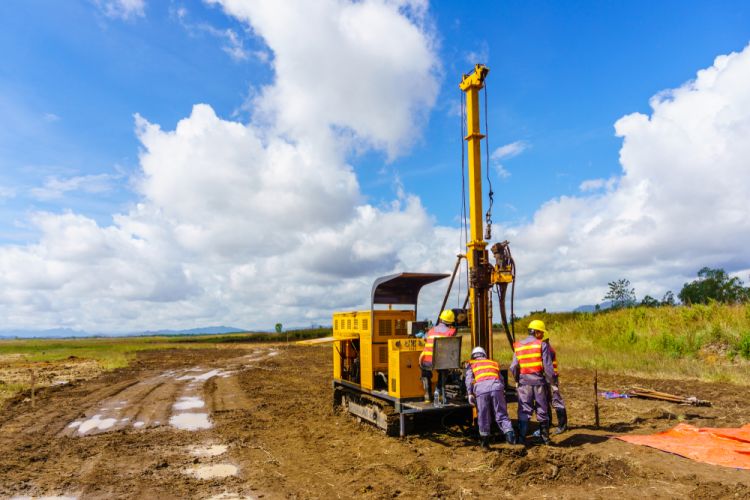The Definitive Guide to Geotechnical Engineering For Construction Projects
The Definitive Guide to Geotechnical Engineering For Construction Projects
Blog Article
Our Geotechnical Engineering For Construction Projects Ideas
Table of ContentsThe Facts About Geotechnical Engineering For Construction Projects Uncovered6 Simple Techniques For Geotechnical Engineering For Construction ProjectsWhat Does Geotechnical Engineering For Construction Projects Mean?The 4-Minute Rule for Geotechnical Engineering For Construction ProjectsNot known Incorrect Statements About Geotechnical Engineering For Construction Projects
Consequently, throughout the investigation, it is important to drill at the needed deepness and the called for variety of holes as per the referral of the Canadian Structure Style criterion. Often, the owner could save some Geotechnical Investigation expense yet end up investing more than the expected throughout the construction price.The duties of the geotechnical consultant entail supplying material screening for building assistance. Geotechnical Engineering for Construction Projects. Geotechnical designers analyse all the field test records to make certain that building and construction is going on as per the project spec. During building, a confirmatory examination for dirt compaction is done on-site to make sure that no future negotiation takes place
After the concrete is poured -7 days and 28 days- examinations are carried out on concrete samples collected from the website to guarantee that the concrete put satisfies the style requirement. Asphalt core is taken after the Asphalt is laid and compressed to confirm that it satisfies the style criterion. All research laboratory examination reports are analysed by the Geotechnical Designer to make certain that it meets the project specification.
The 10-Minute Rule for Geotechnical Engineering For Construction Projects

Geotechnical engineering plays a critical function in ensuring the security of building projects. Geotechnical engineering is a vital branch of civil design that concentrates on recognizing the behavior of earth products, such as dirt and rock.

For a reliable foundation and a smooth building process, depend supply the know-how you need. Get in touch with to obtain expert suggestions and geotechnical solutions customized to your next task.
The Geotechnical Engineering For Construction Projects Statements
When beginning on a land growth project, understanding the ground under your feet is as vital as the structures you intend to construct above it. Our Geotechnical Engineering group analyse the ground, guaranteeing it is ideal for the proposed advancement while supplying you with the info called for to meet your task goals.
Geotechnical Engineering takes a look at the development of the ground, as it is the foundation for all tasks. Where structures require to be developed relative to the ground conditions; ground problems (e.g., soft ground) may require enhancing depending upon the size of the designated structure. Prior to building, you require to understand about the groundwater, dirt structure, and liquefaction likelihood of your land.
For websites that are not attached on the regional authority facilities added website investigations would certainly be needed to supply technological inputs for on-site stormwater and wastewater. We have actually experienced Geotechnical Designers based in each office, supporting your geotechnical needs nationwide. Get to out to us to discuss just how we can sustain your following job.
These reports are tailored to fulfill the details needs of a project and include style specifications and guidance for the building and construction of a series of manufactured frameworks. As well as offering consultancy solutions covering locations such as slope security and load-bearing abilities for various products, these engineers embark on research and development activities to improve methods, tools, products knowledge and evaluation covering entire lifecycles.
Geotechnical Engineering For Construction Projects for Dummies

Nevertheless, rates of pay normally boost as your understanding and abilities grow, with standards indicating a graduate beginning wage of between 18,000 and 28,000 per year in the read the article UK. This increases to 26,000 to 36,000 with a couple of years of experience and after that reaching 40,000 to 60,000+ for elderly, legal or master engineers.
With the right application it is possible to grasp the occupation and gain access to a difficult yet rewarding and vital job. A rock hound would require to retrain to end up being a geotechnical designer, although there is a lot of cross-over in between the two occupations, which could make this easier - Geotechnical Engineering for Construction Projects. Geologists require to have an understanding of soils, rocks and various other materials from a clinical perspective, while geotechnical designers tale their expertise of issues such as soil and rock auto mechanic, geophysics and hydrology and use them to design and environmental tasks
When starting out, these designers will certainly tend to service much less complicated tasks, building up knowledge and experience prepared for even more difficult job later on. Geotechnical designers often tend to specialise in specific locations as they expand in experience, concentrating on specific frameworks such as railways, roads or water. These designers likewise work with renewable resource, offshore and onshore oil and gas, nuclear power, and a lot more.
10 Easy Facts About Geotechnical Engineering For Construction Projects Explained
The time taken to become a geotechnical designer depends upon where you are based, where you study and what degree of education you wish to attain prior to going into the work environment. For instance, are you mosting likely to explore an apprenticeship, take an click now university level or service in the direction of a Master's or PhD? Nevertheless, generally-speaking it takes 3-4 years to reach the basic demands to start a job as a geotechnical designer.
These procedures enable specialists to analyze a host of soil auto mechanics consisting of weight, porosity, void-to-solid bit ratio, leaks in the structure, compressibility, optimum shear toughness, birthing capability and contortions. If the structure needs a deep foundation, designers will certainly make use of a cone infiltration examination to estimate the amount of skin and end bearing resistance in the subsurface.
When examining an incline's equilibrium of shear tension and shear strength, or its capability to endure and undertake movement, rotational slides and translational slides are generally thought about. Rotational slides fail along a rounded surface, with translational slides occurring on a planar surface area. An expert's objective is to identify the problems at which an incline failing might take place.
Usually, findings suggest that a site's soil must be treated to enhance its shear toughness, rigidity and permeability prior to style and construction. When it comes time to outline structure strategies, specialists are increasingly focused on sustainability, more specifically exactly how to minimize a structure's carbon impact. One strategy has been to change 20 percent of a foundation's concrete with fly ash, a waste item from coal fire power plants.
Report this page